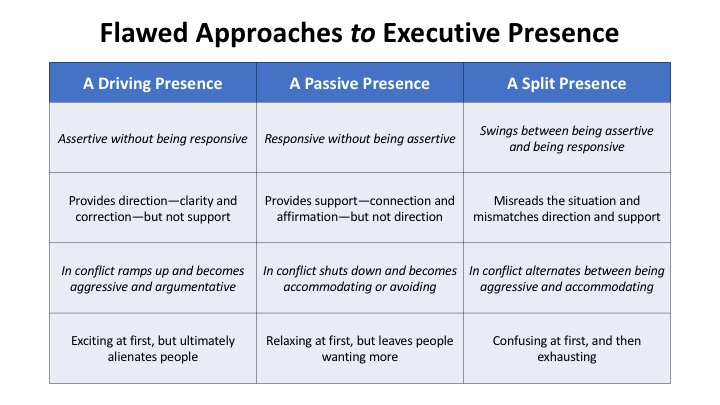This is not a joke.
Two leaders walk into a bar. The one, without saying a word, attracts the attention of every person in the room. The other disappears into the woodwork, or is avoided at all costs.
Why? Executive presence.
Executive presence is the sense of confidence and connection a leader brings to every encounter. It’s a gravitation pull that draws people to that leader, and, in turn, a motivation force that sends people out inspired.
Executive presence is not a matter of personality—both introverts and extroverts have executive presence, each in their own way—but involves finding your own voice and being true to that voice. It’s the authentic expression of the best of who you are that sparks trust in an instant and builds deep loyalty over time.
The best CEO’s have executive presence and so do the best salespeople. The best managers, entrepreneurs, speakers and consultants have it as well. It’s the X-factor in business that’s the difference between being just okay and truly spectacular.
Executive Presence is Not …
Executive Presence is one of those things that’s best understood, at first at least, by what it’s not. It’s not any of the following three (often very) flawed approaches:
A Driving Presence: Assertive but not Responsive
A Driving Presence provides plenty of direction without much support. It’s good at being clear and giving correction, but not so good at the human side of leadership: connecting with people, listening intently, encouraging and affirming them.
In conflict, a Driving Presence ramps up and over-communicates, becoming aggressive and argumentative, pursuing the issue at hand at the expense of the relationship. Think Jack Nicholson in A Few Good Men, “You can’t handle the truth!” Relating to people in this way, leaders with this presence meet their own need for distinctive self expression but not the needs of the organization.
A Driving Presence can be invigorating at first, even exciting, but ultimately it leaves a wake that alienates everyone in its path.
A Passive Presence: Responsive but not Assertive
A Passive Presence provides plenty of support without much direction. It’s good at the human side of leadership, connecting with people well, but not so good at inspiring others to grow and take risks, challenging them to get out of their comfort zone and get better at what they do.
In conflict, a Passive Presence shuts down and disappears, avoiding and accommodating, preserving the relationship at the expense of the issue at hand. Relating to people in this way, leaders with this presence meet the needs the organization but not their own need for distinctive self expression.
A Passive Presence can be relaxing at first, even comforting, but ultimately leaves people underwhelmed, wanting more. Much more.

A Split Presence: Swings between Being Assertive and Responsive
A Split Presence provides inconsistent direction and support. One day it acts one way, the next day it acts in another. Worse yet, when it provides direction or support, it’s often at the wrong time and in the wrong manner, misreading the situation and mismatching responses to it.
In conflict, a Split Presence alternates between aggressiveness and accommodation, not satisfying the issue at hand or the relationship. Relating to people in this way, leaders with this presence experience the worst of both worlds. They don’t meet their own need for distinctive self expression or the needs of the organization.
A Split Presence is confusing at first, as in, “Which leader will show up today?” Then it’s completely exhausting.
Executive Presence
Blends Being Assertive and Responsive
True Executive Presence provides both direction and support. Not, however, in a binary way, “Here’s a little direction … Now here’s a little support.” As if having one foot in a block of ice and one foot in boiling water on average is comfortable.
Executive Presence blends direction and support, like a skilled chef combines diverse ingredients into an exquisite meal. Clarity and connection, challenge and affirmation, candor and compassion are all brilliantly brought together by leaders who possess this presence.
In conflict, Executive Presence doesn’t get emotionally hijacked by the situation and default to fight or flight mode. Instead, it fully collaborates with others in the heat of the moment, utilizing both advocacy and inquiry to address the issue at hand and the relationship.
Leaders who possess Executive Presence are willing to compromise as they work with others, but it’s not their first, knee-jerk reaction. They prefer to find a solution that meets the needs of all parties, even if that solution may take more time to work out.
Relating to people in this way, leaders with this presence meet both their own needs for distinctive self expression and the needs of others. They connect deeply with people at every level of the organization and inspire them to act.
How Do You Get Executive Presence?
You can’t, of course, go to the store and by a box of Executive Presence. It’s developed over time by leaders who pursue the following three priorities outlined in the acronym AIM.
Awareness
Executive Presence begins with self-awareness, knowing which of the flawed approaches to executive presence you’re prone to projecting and the triggers that set off its reactions.
Expand awareness by developing strategies for showing up differently in these situations when your triggers are tripping you up and compensate live, in-the-moment for the weaknesses of your style. Become the very best version of yourself.
Intent
The deep confidence executive presence projects comes from an understanding of one’s self and being true to that understanding.
Intent involves identifying the central, guiding principles of your life—what motivates you to act—and following them no matter what. You may never tell these to another soul (It’s okay if you do, you just don’t have to for Executive Presence to exist), but people sense them in you intuitively.
At its core, Executive Presence lives a life of integrity. What a leader believes on the inside is consistent with how he or she behaves on the outside. This congruence is its source of confidence and composure.
Manner
Executive Presence carries itself well at all times. From dressing professionally to smiling easily, from standing (or sitting) straight to speaking clearly, from a sharp physical appearance to maintaining eye contact in a conversation. All these external, physical mannerisms send a not-so-subtle, unspoken message to people, whether you mean that message or not.
Here’s the Bottom Line
Too often we take our leadership cues from pop culture. A couple of pop culture mantras we’ve thoughtlessly embraced are: you are who you are, and, its corollary, I’ve gotta be me. In other words, change is not possible.
The implication of this proposition is that some people have executive presence and some people don’t. You can’t do anything about it, so don’t even try. Nothing could be further from the truth.
While I’ll grant you this practice comes more readily to some leaders than to others, its mastery is within every leader’s grasp. Become aware of the flawed presence you tend to project and make the critical adjustments needed. Do the deep work of intent, fully aligning your behavior to your beliefs. Own your body language and everything that’s associated with it.
Then watch your leadership effectiveness soar.
“Great leaders move us,” declares Daniel Goleman in the very first sentence of his best-selling book Primal Leadership. “They ignite our passion and inspire the best in us. When we try to explain why they are so effective, we speak of strategy, vision, or powerful ideas. But the reality is much more primal: Great leadership works through the emotions.”
That’s Executive Presence in action.

